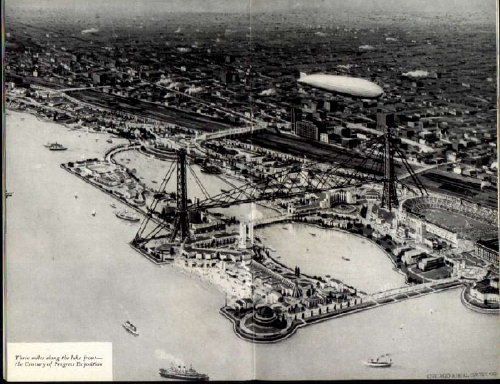The Sky Ride was a transporter bridge designed by Robinson & Steinman and built for the Century of Progress Exposition (or World’s Fair) in Chicago, Illinois (located near what became Meigs Field) in 1933. After the run of the fair concluded, it was demolished in November 1934. It had an 1,850-foot (564-meter) span. Suspended from it, 215 feet (66 meters) above the ground, were 10 (or 12, sources differ) cars, each carrying 36 passengers.
The transporter bridge is much more common in Europe. In the United States, only two transporter bridges were ever built: the Aerial Lift Bridge in Duluth, Minnesota in 1905, and the Sky Ride.
History
The Century of Progress Exposition committee reportedly sought an exciting “signature” attraction, one that would span the grounds but be relatively cheap to build. The ride was built in the span of 6 months prior to the fair”s opening, by a consortium of 5 companies: Great Lakes Dredge and Dock Company, Inland Steel, John Roebling and Sons, Mississippi Valley Structural Steel and Otis Elevator at a cost of about 1,000,000 USD.
It consisted of two towers, each 628 feet high, spaced 1850 feet apart. Each tower had 4 elevators with a 30 person capacity. Fair goers could take a trip across from one tower to the other at the 200 foot level, or take the elevator farther up to the observation decks at the top of the tower. If they chose to take a trip across, they rode in one of 12 double-decked “Rocket Cars” carried across from one tower to the other. Each car emitted steam intended to resemble a “tail” or rocket exhaust, as it traveled across the wires. At night, lights were focused on the cars as they traveled between the towers, and lights were also attached to the bottom of the elevators.
The ride had a capacity of 5,000 people per hour. It was reported that the attraction had 2,616,389 riders in 1933 and a total of about 4.5 million during the course of the fair. At the time of construction the span between towers was one of the longest in the world, allegedly exceeded in span only by the George Washington Bridge, and the towers were higher than any of the skyscrapers then extant in Chicago. It was reported that it contained 2,000 tons of steel, 100 miles of cabling and that the cableway had a breaking strength of 220,000 pounds per square inch.
At the conclusion of the fair the Sky Ride was demolished using dynamite on one tower and a charge of thermite packed around the base of the other.
Brochure
The following brochure text gives a feel for the breathless prose of the day.
Two towers stand like giant sentinels, 1,850 feet apart, seeming to guard the Hall of Science on the Mainland, and the Hall of Social Science across the Lagoon–support of the spectacular Sky-Ride, great thrill feature of A Century of Progress. Back in 1893, it was the monster Ferris Wheel that everybody talked about, and everybody rode. Today, striking example of the progress of science even in thrill makers, is this suspension bridge principle applied to an entertainment feature–and perhaps the near solution of some problems of overhead transportation. They are higher than any building in Chicago, these two strong steel towers, imbedded in cement. Six hundred and twenty-eight feet they rise into the skies, with observation floors atop them. On a 200-foot level the rocket cars offer you a beautiful and, mayhap, thrilling ride across the lagoon.
Discover more from LandmarkLocation.com
Subscribe to get the latest posts sent to your email.


